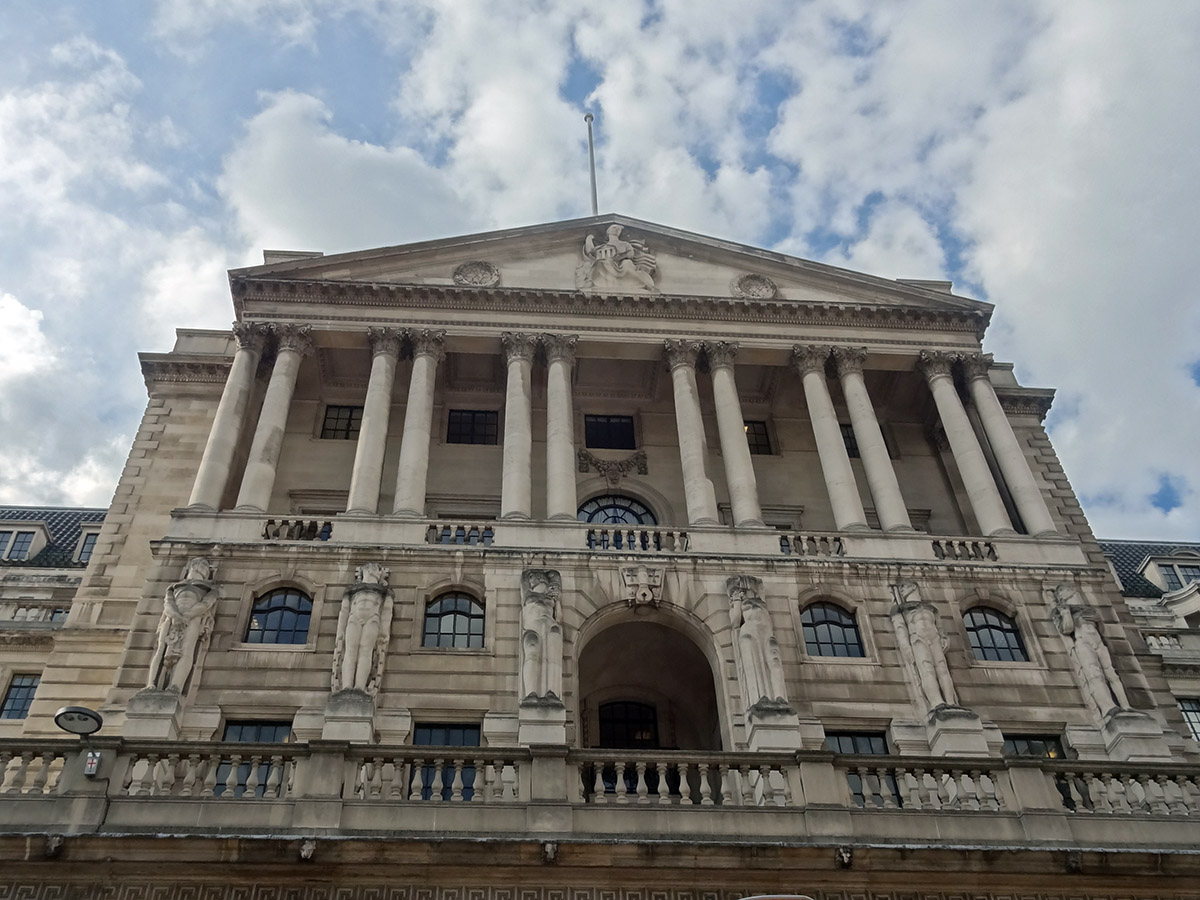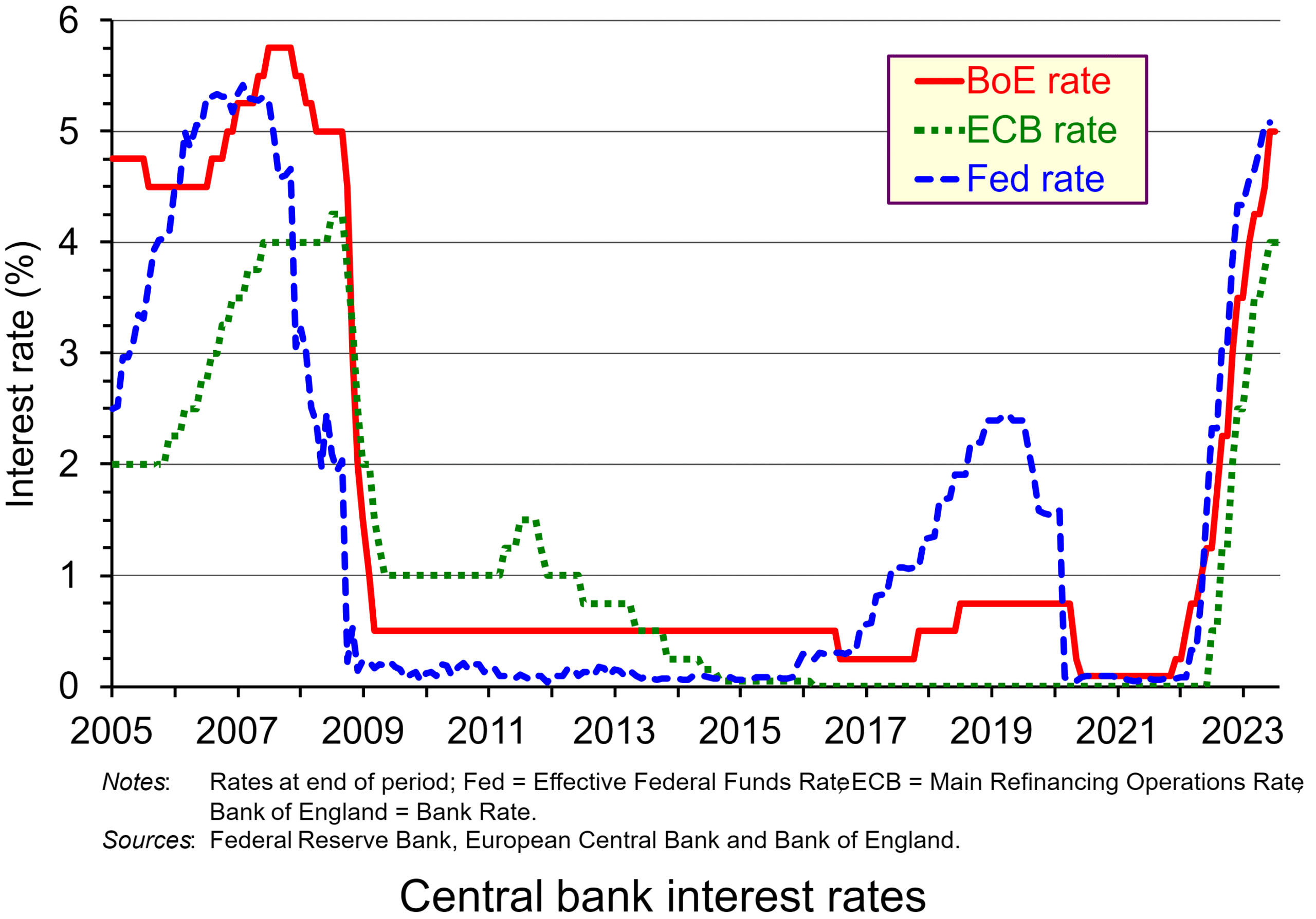Monetary policy: too much, too late?
 In this third blog about inflation, we focus on monetary policy to deal with the problem and bring inflation back to the target rate, which is typically 2 per cent around the world (including the eurozone, the USA and the UK). We ask the questions: was the response of central banks too timid initially, meaning that harsher measures had to be taken later; and will these harsher measures turn out to be excessive? In other words, has the eventual response been ‘too much, too late’, given that the initial measures were too little?
In this third blog about inflation, we focus on monetary policy to deal with the problem and bring inflation back to the target rate, which is typically 2 per cent around the world (including the eurozone, the USA and the UK). We ask the questions: was the response of central banks too timid initially, meaning that harsher measures had to be taken later; and will these harsher measures turn out to be excessive? In other words, has the eventual response been ‘too much, too late’, given that the initial measures were too little?
Inflation rates began rising in the second half of 2021 as economies began to open up as the pandemic subsided. Supply-chain problems drove the initial rise in prices. Then, following the Russian invasion of Ukraine in February 2022 and the adverse effects on oil, gas and grain prices, inflation rose further. In the UK, CPI inflation peaked at 11.1% in October 2022 (see chart 1 in the first of these three blogs). Across the whole EU-27, it peaked at 11.5% in October 2022; US inflation peaked at 9.1% in June 2022; Japanese inflation peaked at 4.3% in January 2023.
This raises the questions of why interest rates were not raised by a greater amount earlier (was it too little, too late?) and why they have continued to be raised once inflation rates have peaked (is it too much, too late?).
The problem of time lags
 Both inflation and monetary policy involve time lags. Rising costs take a time to work their way through the supply chain. Firms may use old stocks for a time which are at the original price. If it is anticipated that costs will rise, central banks will need to take action early and not wait until all cost increases have worked their way through to retail prices.
Both inflation and monetary policy involve time lags. Rising costs take a time to work their way through the supply chain. Firms may use old stocks for a time which are at the original price. If it is anticipated that costs will rise, central banks will need to take action early and not wait until all cost increases have worked their way through to retail prices.
In terms of monetary policy, the lags tend to be long.
If central bank interest rates are raised, it may take some time for banks to raise savings rates – a common complaint by savers.
As far as borrowing rates are concerned, as we saw in the previous blog, loans secured on dwellings (mortgages) account for the majority of households’ financial liabilities (76.4% in 2021) and here the time lags between central bank interest rate changes and changes in people’s mortgage interest rates can be very long. Only around 14 of UK mortgages are at variable rates; the rest are fixed, typically for between 2 to 5 years. So, when Bank Rate changes, people on fixed rates will be unaffected until their mortgage comes up for renewal, when they can be faced with a huge increase in payments.
 Only around 21% of mortgages in England were/are due for renewal in 2023, and with 57% of these the old fixed rates were below 2%. Currently (July 2023), the average two-year fixed-rate mortgage rate in the UK is 6.81% (based on 75% loan to value (LTV)); the average five-year rate is 6.31% (based on 75% LTV). This represents a massive increase in interest rates, but for a relatively small proportion of homeowners and an even smaller proportion of total households.
Only around 21% of mortgages in England were/are due for renewal in 2023, and with 57% of these the old fixed rates were below 2%. Currently (July 2023), the average two-year fixed-rate mortgage rate in the UK is 6.81% (based on 75% loan to value (LTV)); the average five-year rate is 6.31% (based on 75% LTV). This represents a massive increase in interest rates, but for a relatively small proportion of homeowners and an even smaller proportion of total households.
But as more and more fixed-rate mortgages come up for renewal, so the number of people affected will grow, as will the dampening effect on aggregate demand as such people are forced to cut back on spending. This dampening effect will build up for many months.
And there is another time lag – that between prices and wages. Wages are negotiated periodically, normally annually or sometimes less frequently. Employees will typically seek a cost-of-living element in wage rises that covers price rises over the past 12 months, not inflation in the past month. If inflation is rising (or falling), such negotiations will not reflect the current situation. There is thus a time lag built in to such negotiations. Even if higher interest rates reduce inflation, the full effect can take some time because of this wages time lag.
 Other time lags include those involving ongoing capital projects. If construction is taking place, it will take some time to complete and in the meantime is unlikely to be stopped. Higher interest rates will affect capital investment decisions now, but existing projects are likely to continue to completion. As more projects are completed over time, so the effect of higher interest rates is likely to accumulate.
Other time lags include those involving ongoing capital projects. If construction is taking place, it will take some time to complete and in the meantime is unlikely to be stopped. Higher interest rates will affect capital investment decisions now, but existing projects are likely to continue to completion. As more projects are completed over time, so the effect of higher interest rates is likely to accumulate.
Then there is the question of savings. During the pandemic, many people increased their savings as their opportunities for spending were more limited. Since then, many people have drawn on these savings to fund holidays, eating out and other leisure activities. Such spending is likely to taper off as savings are reduced. Again, the interest rises may prove to have been excessive as a means of reducing aggregate demand.
These time lags suggest that after some months the economy will have been excessively dampened and that the policy will have ‘overshot’ the mark. Had interest rates been raised more rapidly earlier and by larger amounts, the peak level of rates may not have needed to be so high.
Perhaps one of the biggest worries about raising interest rates excessively because of time lags is the effect on corporate and government debt. Highly indebted companies and countries will find that a large increase in interest rates makes servicing their debt much harder. For example, Thames Water, the UK’s biggest water and sewerage company accumulated some £14 billion in debt during the era of low interest rates. It has now declared that it cannot service these debts and is on the brink of insolvency. In the case of governments, as increasing amounts have to be spent on servicing their debt, so they may be forced to cut expenditure elsewhere. This will have a dampening effect on the economy – but with a time lag.
The distribution of pain
 Those with large credit-card debt and large mortgages coming up for renewal or at variable rates will have borne the brunt of interest rate rises. These people, such as young people with families, are often those most affected by inflation, with a larger proportion of their expenditure on energy and food. Other people adversely affected are tenants where landlords raise rents to cover their higher mortgage payments.
Those with large credit-card debt and large mortgages coming up for renewal or at variable rates will have borne the brunt of interest rate rises. These people, such as young people with families, are often those most affected by inflation, with a larger proportion of their expenditure on energy and food. Other people adversely affected are tenants where landlords raise rents to cover their higher mortgage payments.
Those with no debts will have been little affected by the hike in interest rates, unless the curbing of aggregate demand affects their chances of overtime or reduces available shifts or, worse still, leads to redundancy.
Excessive rises in interest rates exacerbate these distributional effects.
Articles
- UK homeowners face huge rise in payments when fixed-rate mortgages expire
- Economic ‘Bazball’ will have replaced UK’s safety-first approach to inflation and growth by 2025
- The Bank of Canada just hiked interest rates for the sixth time — is it too late?
- Monetary Policy Report Press Conference Opening Statement
- Some reflections on Monetary Policy past, present and future
- Expectations, lags, and the transmission of monetary policy
- Europe’s monetary policy shift comes (too) late
- Nobel Prize-winning economist says there’s no need for the Fed to keep hiking interest rates
- Three Uncomfortable Truths For Monetary Policy
- Inflation’s return changes the world
- The next revolution in monetary policy is underway
- Inflation may be coming down but its unequal effects can still have a big impact on wellbeing
- Why central banks should stop raising interest rates
 Bank of England’s ‘regrettable’ mistakes fuelled inflation, its former top economist says
Bank of England’s ‘regrettable’ mistakes fuelled inflation, its former top economist says
The Guardian, Richard Partington (17/6/23)
The Guardian, Larry Elliott (16/7/23)
The Conversation, Alexander David (27/10/22)
Bank of Canada, Tiff Macklem (12/7/23)
Bank of England, Speech, Michael Saunders (18/6/22)
Bank of England, Speech, Catherine L. Mann (23/2/23)
DW, Henrik Böhme (6/9/22)
CNBC, Sam Meredith (14/7/23)
IMF, Speech, Gita Gopinath (26/6/23)
Financial Times, Martin Wolf (4/7/23)
Reuters, Felix Martin (30/6/23)
The Conversation, Alberto Prati (19/7/23)
The Conversation, Muhammad Ali Nasir (27/9/23)
Sky News, Daniel Binns (5/9/23)
Questions
- For what reasons might a central bank be unwilling to raise interest rates by more than 0.25 or 0.5 percentage points per month?
- What instruments other than changing interest rates does a central bank have for influencing aggregate demand?
- Distinguish between demand-pull and cost-push inflation.
- Why might using interest rates to curb inflation be problematic when inflation is caused by adverse supply shocks?
- How are expectations of consumers and firms relevant in determining (a) the appropriate monetary policy measures and (b) their effectiveness?
- How could a careful use of a combination of monetary and fiscal policies reduce the redistributive effects of monetary policy?
- How might the use of ‘forward guidance’ by central banks reduce the need for such large rises in interest rates?